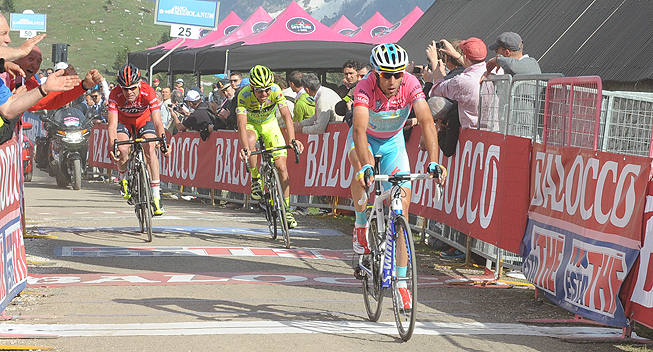This stage starts in the mining village of Cave del Predil (Rabelj in Slovenian, Raibl in German – it was part of Carinthia until 1918). Zinc and lead were probably extracted in pre-Roman times already, and from the 14th century the mines were in continuous operation until 1991.
After descending to Tarvisio, the route proceeds downhill, following the river Fella until its confluence with the Tagliamento. From here, it continues along the Tagliamento and Degano, climbing slightly to Ovaro, well-known and feared as the starting point of the Monte Zoncolan climb. Luckily for the riders, they turn westward, up the long, but not very demanding climb to the Sella Ciampigotto (category 2, gradients mostly around 4%). A fast and technical descent bring the Giro to the Piave valley; after intermediate sprints in Lozzo di Cadore and Pieve di Cadore the peloton follows the Piave river to Longarone.
In Longarone, the small mountain stream Vajont flows into the Piave. In the early 20th century, its narrow gorge was deemed ideal for the construction of a dam to produce electricity for Venezia. The project was approved during World War II, and the 261 m concrete dam – at the time the highest dam in the world – was built in the 1950s against protests from local villagers. During the filling of the reservoir in 1960, residents in Erto e Casso experienced several earthquakes and minor landslides, but authorities hoped that the ground would settle over time. The reservoir was re-filled several times, but eventually the inevitable happened: Late on the 9th of October much of the northern slope of the Monte Toc fell into the lake, causing a huge flood wave and then overflowing the dam in a 250 m high wave. Longarone was completely destroyed, as were other villages further down the Piave valley. At least 1917 died, although the exact number could never be established.
50 years later, the Giro pays tribute to the victims of this disaster with this stage finish.
After crossing the Piave in Longarone, the climb starts with 7 km to go. The steepest section of 9% comes shortly before the 5 km sign, and then the gradient eases to around 5-6% through a series of hairpins. The road passes through three tunnels, bypassing the Vajont dam 1500 m from the finish line. On this last part, the road steepens to above 7% and stays that way until around 200 m from the line. The last 200 m are downhill.
It is hard to predict what will happen on this stage. After the hard final climb to Altopiano del Montasio the day before, some of the GC favourites may want to take it easy, leaving the stage win to a breakaway and using this stage as a rolling rest day. However, with two easier stages coming up in the next days, others could try to put the pressure on. If it rains, the downhill devils among the favourites (I’m mainly thinking of Nibali) may want to put Wiggins in trouble on the Ciampigotto descent already, possibly using a teammate placed into the early breakaway as a springboard on the run-in to the final climb. But even if nothing happens until Longarone, the final 7km should ensure some action from the maglia rosa contenders.
| David MELVILLE 37 years | today |
| Po Sen CHIU 38 years | today |
| Alfredo RIOS 40 years | today |
| Chi Yin LEUNG 43 years | today |
| Samuel LEROUX 30 years | today |
© CyclingQuotes.com









